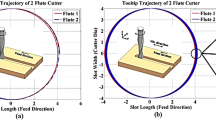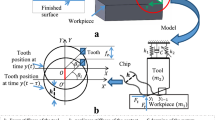Abstract
In grinding, regenerative vibration and forced vibration due to grinding wheel eccentric rotation are main excited-vibration sources that interact with grinding material removal mechanism. In the paper, instantaneous undeformed chip thickness in down-grinding cutting phase may consist of two components, i.e. linear kinetic thickness and nonlinear dynamic thickness. Considering abrasive grit-workpiece interaction in the grinding contact zone, the grinding vibration system is presented by a new set of differential equations of two degrees of freedom (DOF) with a close-loop feedback control system models. Conventional grinding control parameters, including wheel spindle speed, work-speed in feed direction and radial cutting depth, are often regarded as linear constants in many existing simplified models. When considering time delay, they can be transferred to nonlinear variables, so the capability of prediction and the accuracy of solution of the grit-workpiece dynamic performance are improved. Based on quantitative comparison of force and vibration magnitudes, the influence of the eccentric rotation of abrasive wheel and the negative rake angle of working grit cutting edges on grinding performance are demonstrated in the paper.
Similar content being viewed by others
References
Aurich JC, Kirsh B (2012) Kinematic simulation of high-performance grinding for analysis of chip parameters of single grits. CIRP J Manuf Sci Technol 5:164–174
Li XK, Wolf S, Zhu TX, Zhi G, Rong YM (2015) Modeling and analysis of the bonding mechanism of CBN grit for electroplated superabrasive tools—part 1: introduction and application of a novel approach for determining the bonding force and the failure modes. Int J Adv Manuf Technol 76:2051–2058
Li XK, Wolf S, Zhu TX, Zhi G, Rong YM (2015) Modeling and analysis of the bonding mechanism of CBN grit for electroplated superabrasive tools—part 2: finite element modeling and experimental verification. Int J Adv Manuf Technol 77:43–49
Darafon A, Warkentin A, Bauer R (2013) 3D metal removal simulation to determine uncut chip thickness, contact length and surface finish in grinding. Int J Adv Manuf Technol 66:1715–1724
Chen X, Öpöz TT (2014) Characteristics of material removal processes in single and multiple cutting edge grit scratches. Int J Abras Technol 6:226–242
Malkin S, Cai GQ (2002) Grinding technology theory and applications of machining with abrasive (in Chinese). Northwestern University Press, Xi’an
Inasaki I, Karpuschewski B, Lee H (2001) Grinding chatter-origin and suppression. Ann CIRP Manuf Technol 50:515–534
Altintas Y, Weck M (2004) Chatter stability of metal cutting and grinding. Ann CIRP Manuf Technol 53:619–642
Jiang JL, Ge PQ, Hong J (2013) Study on micro-interacting mechanism modelling in grinding process and ground surface roughness prediction. Int J Adv Manuf Technol 67:1035–1052
Fu YC, Tian L, Xu JH, Yang L, Zhao JY (2015) Development and application on the grinding process modeling and simulation. J Mech Eng 51:198–205
Hou ZB, Komanduri R (2003) On the mechanics of the grinding process—part I, stochastic nature of the grinding process. Int J Mach Tools Manuf 43:1579–1593
Agarwal R, Rao PV (2012) Predictive modeling of undeformed chip thickness in ceramic grinding. Int J Mach Tools Manuf 56:59–68
Linke BS (2015) A review on properties of abrasive grits and grit selection. Int J Abras Technol 7:46–58
Ren JX, Kang RK, Shi XK (1992) Grinding technology of difficult-to-machine materials (in Chinese). National Defence Industry Press, Beijing
Ren JX, Hua D (2011) Grinding principle (in Chinese). Publishing house of electronics industry. Beijing, China
Badger J, Murphy S, O'Donnell G (2011) The effect of wheel eccentricity and run-out on grinding force, waviness, wheel wear and chatter. Int J Mach Tools Manuf 51:766–774
Aurich JC, Herzenstiel P, Sudermann H, Magg T (2008) High-performance dry grinding using a grinding wheel with a defined grit pattern. Ann CIRP Manuf Technol 57:357–362
Axinte D, Butler-Smith P, Akgun C, Kolluru K (2013) On the influence of single grit micro-geometry on grinding behavior of ductile and brittle materials. Int J Mach Tools Manuf 74:12–18
Rasim M, Mattdeld P, Klocke F (2015) Analysis of the grit shape influence on the chip formation in grinding. J Mater Process Technol 226:60–68
Werner G (1978) Influence of work material on grinding force. Ann CIRP 27:243–248
Yu TB, Zhang JQ, Peng G, Wang WS (2010) Investigation of grinding process simulation. Adv Mater Res 126-128:119–124
Huang H, Lin SH, Xu XP (2010) Study on grinding forces for glass grinding with single diamond grit (in Chinese). China Mech Eng 21:1278–1282
Klocke F, Barth S, Mattfeld P (2016) High performance grinding. 7th HPC 2016-CIRP Conf High Performance cutting 46: 266-271
Winter M, Ibbotson S, Kata S, Hermann C (2015) Life cycle assessment of cubic boron nitride grinding wheels. J Cleaner Prod 107:707–721
Funding
The work is supported by the State Key Program of the National Natural Science of China (grant no. 51235004) and the National Natural Science Foundation of China (grant no. 51575198).
Author information
Authors and Affiliations
Corresponding author
Rights and permissions
About this article
Cite this article
Chen, Y., Chen, X., Xu, X. et al. Quantitative impacts of regenerative vibration and abrasive wheel eccentricity on surface grinding dynamic performance. Int J Adv Manuf Technol 96, 2271–2283 (2018). https://doi.org/10.1007/s00170-018-1778-3
Received:
Accepted:
Published:
Issue Date:
DOI: https://doi.org/10.1007/s00170-018-1778-3




